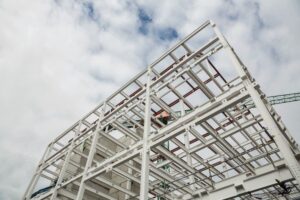
Optimizing Factory Acoustics: A Guide to Reducing Noise Pollution in Industrial Facilities
Industrial facilities produce everything from consumer goods to high-tech components. These factories, however, can become noisy due to heavy machinery and high volumes of operations.
Excessive noise not only impacts worker productivity but also poses serious health risks, including hearing damage and stress. As industries grow, optimizing factory acoustics to reduce noise pollution has become a priority for both operational efficiency and worker safety.
This article explores the importance of controlling noise in industrial settings, the effects of noise on workers, and effective strategies for optimizing factory acoustics.
Why Is Noise Control Important in Industrial Settings?
Industrial facilities often operate with high levels of mechanical equipment, HVAC systems, and assembly lines, all of which generate significant noise. According to the World Health Organization (WHO), noise pollution is a leading environmental health risk, especially in industrial environments. In India, with rapidly growing manufacturing sectors like automotive, textiles, and electronics, the need for noise control is more pressing than ever.
Excessive noise in factories can lead to reduced concentration, communication issues, and long-term hearing loss. In fact, occupational noise exposure is a leading cause of permanent hearing impairment among workers.
The Effects of Excessive Noise on Workers
1. Health Issues
Noise pollution in industrial facilities is not only uncomfortable, but it also has long-term health consequences. Chronic noise exposure can lead to hearing loss, which is often irreversible. In addition to auditory damage, noise pollution can increase the risk of hypertension, stress, and cardiovascular diseases.
High levels of noise can also interfere with workers’ ability to focus, leading to errors and accidents. As concentration drops in noisy environments, workers may struggle to hear important sounds, such as alarms or instructions from colleagues, which can compromise safety.
2. Decreased Productivity
Studies have shown that prolonged exposure to loud environments can significantly reduce worker productivity. Workers in noisy environments often experience fatigue, frustration, and irritation, all of which impact their efficiency and overall performance.
High noise levels can also hinder communication between workers, slowing down tasks that require coordination.
3. Increased Risk of Accidents
It is more likely that accidents occur in factories that are noisy because important auditory cues – such as machine warnings or approaching forklifts – are drowned out.
According to research, workers in noisy industrial settings are more likely to experience accidents than those in quieter environments. This not only increases operational costs but also places a burden on worker safety and well-being.
Effective Strategies for Reducing Noise Pollution in Factories
To address these concerns, factories need to adopt a proactive approach to noise control. Below are some key strategies that can help reduce noise pollution in industrial settings.
1. Use of Acoustic Barriers
Acoustic barriers, such as soundproof walls or baffles, are an effective way to isolate noise. These barriers can be placed around noisy machinery or specific work zones to contain sound and prevent it from spreading throughout the facility. The material used in these barriers, such as foam, fiberglass, or soundproofing panels, is designed to absorb sound and prevent reverberation.
Acoustic barriers are especially useful in factories where noise levels are consistently high due to the operation of machinery or equipment. By creating soundproof zones, these barriers help keep noise contained, minimizing the overall noise pollution.
2. Vibration Isolation and Equipment Modifications
Many of the loudest noises in industrial settings are generated by vibrating equipment, such as compressors, motors, and pumps. To minimize this, factory managers can use vibration isolation techniques to reduce the transmission of vibrations through floors, walls, and ceilings. Installing rubber mounts, vibration pads, or isolation feet under machines can help absorb vibrations and significantly reduce noise levels.
Additionally, modifying machinery with quieter components or installing sound-dampening covers can also help reduce noise. Regular maintenance of machines to ensure they are operating at optimal efficiency is another important factor, as poorly maintained equipment tends to generate more noise.
3. Installing Acoustic Tiles and Panels
The strategic installation of acoustic tiles or panels in factory ceilings, walls, and floors can significantly reduce the noise reverberating within the facility. These tiles are designed to absorb sound and prevent it from bouncing off hard surfaces, creating an overall quieter environment.
Acoustic panels are particularly effective in large, open-plan spaces where noise tends to echo. By incorporating acoustic materials into the design of the factory, companies can create a more comfortable and productive environment for their workers.
4. Implementing Quiet Work Zones
One of the most effective ways to manage noise in industrial facilities is by designating quiet zones for tasks that require focus and concentration. These areas can be equipped with soundproofing materials and strategically placed away from high-noise zones like assembly lines or machinery rooms.
In addition to providing quieter environments for workers, these areas can also help reduce noise-related distractions, improving productivity and efficiency in tasks that require precision and attention to detail.
5. Regular Monitoring and Assessment
Monitoring noise levels within the factory is an essential part of maintaining a safe and productive working environment. Implementing noise monitoring systems can help track sound levels throughout the facility, ensuring they stay within the recommended limits. Regular noise assessments also help identify areas where noise levels are particularly high and need further intervention.
By conducting routine noise audits, factory managers can address noise problems proactively, making necessary adjustments to ensure that workers are not exposed to harmful levels of sound.
Take Action for a Quieter, Safer Factory
Reducing noise pollution in industrial facilities is crucial for worker health, productivity, and safety. By implementing strategies such as acoustic barriers, vibration isolation, acoustic panels, and quiet work zones, factories can significantly reduce noise levels and improve the overall work environment.
For businesses looking to optimize factory acoustics, VMS Consultants offers engineering, architecture, and project management services. We can help design industrial spaces that prioritize noise reduction, ensuring a healthier and more efficient workplace for your team.
Contact us today to create a quieter, safer, and more productive industrial environment.






